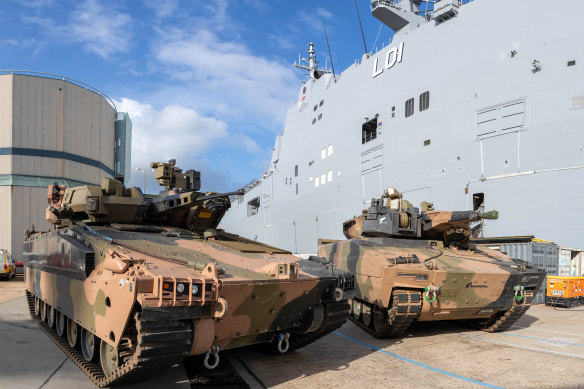Former senior Australian Army officers and military experts insist Australia would need armoured vehicles in any potential armed conflict, saying it is unrealistic a potential war would only be fought at long-range.
The Albanese government has decided to slash the number of new infantry fighting vehicles it was planning to buy from 450 to 129 off the back of last week’s Defence Strategic Review, which means Australia will only have enough for one mechanised battalion.

South Korean company Hanwha’s Redback and Rheinmetall’s Lynx were competing to be selected as the army’s next infantry fighting vehicle, but the project has been significantly cut back.
The army had previously planned to buy enough of the vehicles for three battalions, at a cost of up to $27 billion, to replace Australia’s Vietnam war-era armoured personnel carriers.
The government has also cancelled the purchase of a second regiment of self-propelled howitzer artillery weapons on the basis that they would “not provide the required range or lethality”.
The savings will allow Australia to purchase additional HIMARS rocket launchers and land-based anti-ship missiles.
Gus McLachlan, a retired major-general who led the largest command within the Australian Army until 2018, said it was unrealistic that a future war with China would only be fought with long-range missiles.
“Army are on the nose in Western democracies because the last couple of wars that we have had a go at have been long, nasty, messy, inconclusive – and so as a result we get this swimming back to this idea that you can make war clinical, short and fought at long-range,” he said.
“I think that’s a natural reaction [but] my personal view is it’s unrealistic. I don’t think there is any such thing as a short war and I think the precision munitions – Ukraine has shown us that our stock holdings would run out in a matter of days.”
McLachlan said the army has “not done a great job” of explaining how they would contribute to a maritime strategy in a future war.
In a conflict with China, he said armoured vehicles and artillery would have a role to play in protecting HIMARS and anti-ship missiles deployed in the islands to Australia’s north.
“I think a small number of highly protected army capabilities – light infantry fighting vehicles and some tanks – would make an adversary’s challenge of dislodging those rockets and missiles and radars very difficult,” he said.
John Blaxland, a professor of international security and intelligence studies with the ANU and former army officer, said one battalion of armoured fighting vehicles would not be enough in a protracted conflict.
“With three you can then rotate. If you only have one it’s a one shot capability. You can’t rotate. You can’t have one reconstituting, one preparing and one deployed,” he said.
Blaxland said the government wasn’t prepared to spend any more money over the forward estimates, and the army was the victim.
“The dollars belie the rhetoric,” he said. “The rhetoric, in my view, is wholly accurate, responsible and reasonable – given the gravity of the circumstances and the scale of the challenge we face with a relatively diminished United States, and a dramatically expanded and adventurous People’s Republic of China military capability.”
Australia Defence Association executive director Neil James said the argument that Australia needed less armoured vehicles disregards “the last 400 metres” of a battle.
“When you’re assaulting a position with soldiers, they’re not bulletproof,” he said. “So they need to assault in an armoured vehicle supported by heavier armoured vehicles, called tanks, and by a self-propelled gun to keep up with the mobility of the other two.”
James said he was hopeful that the decision would be reversed in the coming years.
“The decision is so illogical that eventually it will be overturned and the army will get what it needs for the defence of the country. But no one will admit that at the moment,” he said.
Defence Industry Minister Pat Conroy this week said the savings from cutting back on the infantry fighting vehicles and howitzers will fund the “acceleration and expansion” of HIMARS rocket systems, land-based missiles and landing craft.
“So at the end of this process, we’ll go from an Australian Army where the maximum range of the weapons is 40 kilometres to being able to fire missiles, initially over a range of 300 kilometres, and with the acquisition of the precision strike missile, ranges in excess of 500 kilometres,” he said.
“This is about giving the Australian Army the firepower and mobility it needs into the future to face whatever it needs to face.”
He said the two countries involved in the bids to deliver the infantry fighting vehicles – South Korea and Germany – had been consulted and would come back with a revised pricing for 129 vehicles.
Cut through the noise of federal politics with news, views and expert analysis from Jacqueline Maley. Subscribers can sign up to our weekly Inside Politics newsletter here.